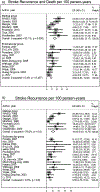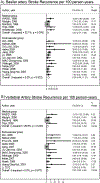Stroke recurrence rates among patients with symptomatic intracranial vertebrobasilar stenoses: systematic review and meta-analysis
- PMID: 25501448
- PMCID: PMC6310226
- DOI: 10.1136/neurintsurg-2014-011458
Stroke recurrence rates among patients with symptomatic intracranial vertebrobasilar stenoses: systematic review and meta-analysis
Abstract
Background: A recent randomized trial of patients with primarily anterior circulation intracranial artery stenosis showed that intensive medical therapy was superior to intracranial stenting in preventing recurrent stroke. The rate of stroke recurrence or death in symptomatic intracranial vertebrobasilar stenosis with medical therapy alone may be especially high, and rates compared with endovascular therapy need further study.
Methods: We conducted a systematic review and meta-analysis of studies reporting the rates of stroke recurrence or death (the primary outcome) in symptomatic intracranial vertebrobasilar stenosis with medical or endovascular treatment over a minimum follow-up period of 6 months. We included all studies in any language indexed in MEDLINE or EMBASE, supplemented by bibliography searches and by contacting the authors. The secondary endpoints were stroke recurrence, and basilar artery and vertebral artery stroke recurrence rates.
Results: 23 studies (592 medical treatment patients and 480 endovascular treatment patients) were included. The risk of combined stroke recurrence or death was 14.8 per 100 person-years (95% CI 9.5 to 20.1) in the medical group compared with 8.9 per 100 person-years (95% CI 6.9 to 11.0) in the endovascular group. The incidence rate ratio was 1.3 (95% CI 1.0 to 1.7). The stroke recurrence rate was 9.6 per 100 person-years (95% CI 5.1 to 14.1) in the medical group compared with 7.2 per 100 person-years (95% CI 5.5 to 9.0) in the endovascular group.
Conclusions: Our results showed that the risk of stroke recurrence or death or the risk of stroke recurrence alone was comparable between the medical and endovascular therapy groups. A small preventive effect of endovascular therapy may exist, particularly if the 30 day postprocedural risk is reduced.
Keywords: Atherosclerosis; Stenosis; Stent; Stroke.
Published by the BMJ Publishing Group Limited. For permission to use (where not already granted under a licence) please go to http://www.bmj.com/company/products-services/rights-and-licensing/
Figures


References
-
- Gulli G, Khan S, Markus HS. Vertebrobasilar stenosis predicts high early recurrent stroke risk in posterior circulation stroke and TIA. Stroke 2009. August;40(8):2732–2737. - PubMed
-
- Marquardt L, Kuker W, Chandratheva A, Geraghty O, Rothwell PM. Incidence and prognosis of > or = 50% symptomatic vertebral or basilar artery stenosis: prospective population-based study. Brain 2009. April;132(Pt 4):982–988. - PubMed
-
- Prognosis of patients with symptomatic vertebral or basilar artery stenosis. The Warfarin-Aspirin Symptomatic Intracranial Disease (WASID) Study Group. Stroke 1998. July;29(7):1389–1392. - PubMed
-
- Qureshi AI, Ziai WC, Yahia AM, Mohammad Y, Sen S, Agarwal P, et al. Stroke-free survival and its determinants in patients with symptomatic vertebrobasilar stenosis: a multicenter study. Neurosurgery 2003. May;52(5):1033–9; discussion 1039–40. - PubMed
-
- Yu W, Smith WS, Singh V, Ko NU, Cullen SP, Dowd CF, et al. Long-term outcome of endovascular stenting for symptomatic basilar artery stenosis. Neurology 2005. March 22;64(6):1055–1057. - PubMed
Publication types
MeSH terms
Grants and funding
LinkOut - more resources
Full Text Sources
Other Literature Sources
Medical
